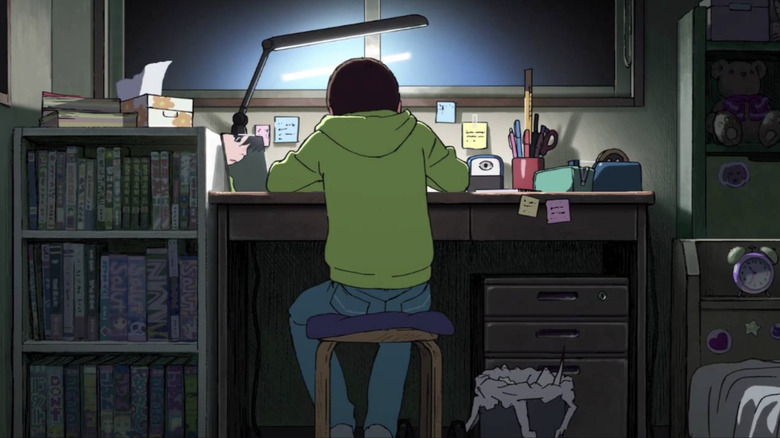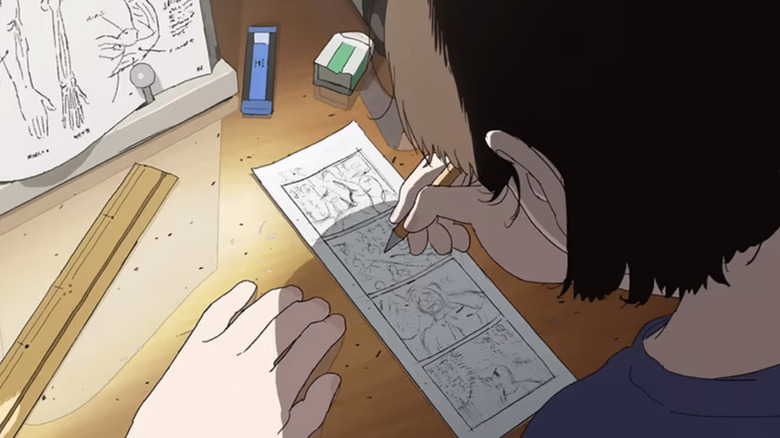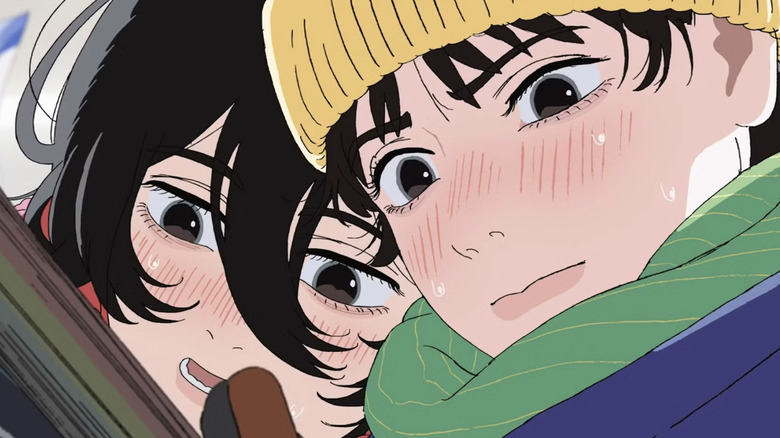One Of 2024's Best Animated Movies Is Based On A Story By The Creator Of Chainsaw Man
We may receive a commission on purchases made from links.
2024 has seen some great animated films. Dreamworks' "The Wild Robot" has deservedly won over audiences' hearts (and the box office). "Transformers One" — a much different movie about robots — has also gotten some of the best reviews in a franchise that too often has been a punchline.
But my favorite animated film so far this year is one that might have slipped under your radar: director Kiyotaka Oshiyama's "Look Back," distributed stateside in a limited run by GKids. The film follows two Japanese girls, the plucky and bold Fujino (Yuumi Kawai) and shut-in Kyomoto (Mizuki Yoshida), who meet and become friends due to their mutual interest in art. As they draw together, they pull apart.
Adapted from a 140-page one-shot manga, "Look Back" is short and sweet like its source material. The author is Tatsuki Fujimoto, most famous for the serialized manga (and acclaimed anime adaptation) "Chainsaw Man." A realistic character drama like "Look Back" has, on the surface, no overlap with that wacky body horror-superhero comic. But "Look Back" is Fujimoto laying his heart on the page (for Oshiyama to pick up) and asking himself why he tells a story like "Chainsaw Man" at all.
Look Back is a manga about making manga
Envy comes with the territory of being an artist. No matter how confident you are, being impressed by another's work comes with the second feeling of wishing that you'd made it yourself.
That's what Fujino experiences early in "Look Back." As a grade schooler, she's praised for her four panel manga strips published in the school newspaper. Then the truant, unseen Kyomoto debuts her column and Fujino falls on her face at the sight of the professional looking sketches. She hunkers down and practices drawing day and night, but even after years of filling sketchbooks, her style isn't as polished as Kyomoto's.
This seems to be a classic Mozart and Salieri story of artistic jealousy, but Fujimoto takes this dynamic in a happier direction. As teenagers, Kujino meets Kyomoto and learns her "rival" is her no.1 fan, as impressed by her comedy doodles as Fujino was by her polished landscape art. Fujino keeps a cool face but you can tell her heart is pumping from the praise. She thought Kyomoto was too far ahead for her to ever catch up, now she learns her imagined challenger really thought the exact same thing of her?
There is not one singular skill for being an artist. Kyomoto draws with beautiful, lifelike detail, and Fujino has an inventive sense of story and humor. So they decide to draw together, in a partnership that plays to their strengths; Kyomoto draws the backgrounds, while Fujino comes up with the story and characters to fill them.
"Look Back" is a play on (English) words; many frames of the manga and film are wide shots looking at Fujino and Kyomoto's backs as they're hunched over desks, drawing. Making art is hard, and "Look Back" suggests the process itself can't offer self-gratification — only sharing it can. Oshiyama has called his film a rebuttal to generative AI, one that champions the necessity of human intention and craft. I walked away from the film feeling more awed than ever by artists and their imaginations; when expressing ourselves, we writers are limited to words.
Tatsuki Fujimoto's manga blurs the line of comic and movie
Fujimoto loves movies, and that love influences how he makes his manga. The opening titles of the "Chainsaw Man" anime are littered with movie references, from "Reservoir Dogs" to "The Big Lebowski." One shot even has the main characters sitting in a movie theater, watching an unseen picture together.
Then there's Fujimoto's other one-shot about being an artist: "Goodbye, Eri," in which a boy named Yuta makes a documentary about his terminally ill mother, and then another about the titular girl he meets. The comic is framed through Yuta's cell phone as he films the world passing by around him. The comic is Fujimoto's greatest blending of form yet, a comic in the style of a found footage film.
I maintain a key strength of the comic medium is its stillness and juxtaposition; you can place multiple images in sequence and your reader can soak them all up simultaneously. Oh sure, movies can do match cuts with a jump from one frame to a similar one, but a comic can do a match cut and leave you staring at both images together, taking in exactly how they match. "Look Back" the manga leans heavily on this, using several panels of Fujino at her desk while the background around her changes. Life remains moving, but she's stuck in her drawing.
Like Fujimoto in "Goodbye, Eri," Oshiyama blends the two mediums. While a moving montage is the core of film editing, many of those montages in "Look Back" (such as snapshots of Fujino and Kyomoto's time together) are still images, not kinetic ones.
The movie makes you focus on one image, like a comic, but gives them a backdrop of music like only a film can. Sound is the sense most tied to my heart, so between Haruka Nakamura's score — and the feeling of time passing from one image vanishing — the movie's ending is even more emotional than the comic's. The story of "Look Back" has been told across two mediums, and both original and adaptation honor the strengths of both.
"Look Back" is currently playing a limited release in U.S. theaters.


